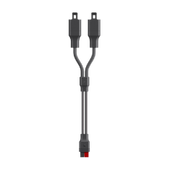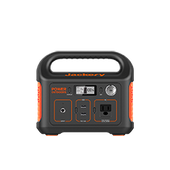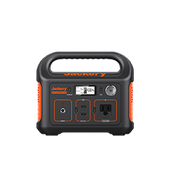Coffee is more than a morning drink for most people, and a considerable amount of power goes into running a coffee maker. So, it’s crucial to understand how many amps a coffee maker uses. Although the usage depends on the respective brand, size, and efficiency, a coffee machine consumes around 2.5-13 amps of current. That’s not very high but can add up if you’re a coffee addict or keep it on for long periods.
The smart decision here is to invest in an alternative battery backup solution. Solar-powered generators provide the most value due to the use of clean, free-to-use fuel and are known for their reliability and safety. Jackery Solar Generators, with their portability and efficiency, become one of the top choices to power your coffee maker in the event of power outages or outdoor camping.
Key Takeaways
- A coffee maker consumes around 2.5-13 amps of electricity, but its actual value varies with the size, brand, and efficiency.
- Coffee makers don’t require a starting wattage/amps. To calculate the amps value, look in the manual or on the manufacturer’s website, use the formula Amps = Watts ÷ Volts, or install a power meter.
- To save on electric bills, set a brewing duration, turn off the appliance when not in use, and invest in coffee makers that take less time to brew coffee.

How Many Amps Does a Coffee Maker Use?
Coffee makers consume a moderate amount of power compared to other household appliances. On average, a 120V coffee maker consumes around 2.5-13 amps of electricity to deliver an optimal performance.
The exact amount, however, depends on size, features, and performance. For example, a smaller 2-cup coffee maker needs around 2.5 to 5 amps for an ideal performance. Similarly, a 10/12-cup coffee maker consumes around 8.3 to 12.5 amps to prepare a desired cup of coffee.
Also, a coffee maker’s brand varies its power consumption ability. So, for example, if you ask how many amps a Bunn coffee maker uses, the answer would be between 6.8 and 7.0 amps. Likewise, a standard-size Keurig Coffee maker needs around 3.3 amps and 12.5 amps daily. The amperage usage varies with the size and efficiency of the respective coffee makers.
Definition of Amps, Volts, Watts, Running Watts
If you’re wondering how many amps a coffee maker uses, let’s start by understanding basic terminology like watts, amps, volts, and running watts. Identifying these helps you determine how many amps a coffee machine uses during startup and confirm its compatibility with a power station.
Amp: Amp, short for amperage, is a unit of measure for the amount of electricity that passes through a wire. It’s the rate at which current flows or the number of electrons that move through a circuit. For example, a coffee maker rated at three amps requires three amps of current to function optimally. You can calculate the amperage value using the formula that says:
Amps = Watts/ Volts
So, if a coffee maker is rated as 600W and 120V, the respective amps value will be:
Amps 600W/120V = 5 amps.
Volt: Volts, represented by V, is the pressure that pushes a current through the wire. Otherwise, it also is the speed at which an individual electron moves through the circuit. Most standard coffee makers in the US are rated 120V. You can also calculate the exact value using the wattage and amperage information. Use the formula:
Volts = Watts / Amps
So, if the appliance consumes 600W and 5 amps, the volts are calculated as:
Volts= 600W/5A = 120V
Watts: Watts is a measure of power and denotes the amount of electricity an appliance needs to operate. So, how many watts a coffee maker uses depends on its size and features. The bigger the machine with loaded features, the more the wattage. For example, a 12-cup coffee maker consumes around 550 to 750 watts, compared to 400W for a 4-cup coffee maker.
Watts = Volts × Amps
Running Watts: Simply put, running watts are the electricity a coffee maker or any other appliance needs to keep running. The formula to calculate running watts is as follows:
Running Watts = Volts × Running Amps
For detailed information about amps, watts, and volts, check out the ultimate guide, which details them with examples.
How Many Amps Do Different Coffee Makers Use?
The amperage usage of a coffee maker varies with the brand, size, efficiency, and features. For example, a 12-cup Keurig coffee maker uses around 12.5 amps of electricity. The table below illustrates how many amps a Keurig coffee maker uses, and the same for other brands like Ninja, Bunn, etc. Also, it shows the amps calculation of the respective coffee maker in detail:
|
Different Coffee Makers |
Rated Watts |
Actual Watts |
Amps (= Watts / Volts) |
|
Keurig Coffee Maker |
396-1500 watts |
396-1500 watts |
3.3 to 12.5 amps |
|
Ninja Coffee Maker |
1104-1452 watts |
1104-1452 watts |
9.2 to 12.1 amps |
|
Bunn Coffee Maker |
816 to 840 watts |
816 to 840 watts |
6.8 to 7 amps |
|
5-cup Coffee Maker |
600 to 960 watts |
600 to 960 watts |
5 to 8 amps |
|
10/12-cup Coffee Maker |
996 to 1500 watts |
996 to 1500 watts |
8.3 to 12.5 amps |
Also, the power requirements of your coffee maker depend on whether it’s actively brewing coffee or just keeping it warm. Here’s a table for that:
|
Different Coffee Maker Modes |
Rated Watts |
Actual Watts |
Amps (= Watts / Volts) |
|
Actively Brewing |
1100-1500 watts |
1100-1500 watts |
9.2 to 12.5 amps |
|
Keeping the Coffee Warm |
550-750 watts |
550-750 watts |
4.6 to 6.3 amps |
How Many Amps Does a Coffee Maker Draw on a Startup
Although a coffee maker's wattage requirements alter with its operation mode, there isn’t a surge in wattage on startup. The consumption rate also depends on the size and efficiency of the coffee maker.
Startup Watts vs. Running Watts
Starting watts is the extra bit of power an appliance takes around two to three seconds to kick start its operation. The highest wattage requirement applies to appliances with compressors or motors. So, you must keep a note of these to select a suitable battery backup solution. Here’s an appliance wattage chart for reference.
A coffee maker continuously draws a certain amount of energy to keep operating optimally. As mentioned earlier, it depends on the brand, features, and size. For example, a Ninja Coffee Maker requires around 1104 to 1452 watts of power, while a Bunn coffee maker needs 816 to 840 watts.
Startup Amps vs. Running Amps
As coffee makers don’t require an additional surge of wattage during startup, so starting amps won’t be applicable. In other words, the starting amps of a coffee maker are equal to its running amps.
How to Calculate Your Coffee Maker Amps
Understanding the ampere consumption of different coffee makers enables customers to make choices aligned with their brewing preferences and power usage expectations. Knowing the value is the first step in choosing a coffee maker and an alternate, reliable battery backup solution. So, here are the best ways:
Method #1: User Manual or Online
The power ratings of a coffee maker, that is, its amps, watts, and volts, are imprinted on the rating plate or in the product manual. So, thoroughly go through them and take note of them. If any information is missing, you can look online on the manufacturer’s website. Those online community forums might also be useful.
Method #2: Determine Amps From the Wattage
Typically, the user manual or website details certain information, such as the watts and volts values. If so, you can use the formula Amps = Watts/Volts. Let’s consider you have a Keurig coffee maker with a rated wattage and voltage of 1000W and 120V, respectively.
So, Amps= 1000W/120V = 8.3 amps
Method #3: Use a Power Meter
Using a power meter is the last resort for determining the amps value of your coffee maker. The obtained values are pretty accurate. Plug the power meter into the power outlet and the coffee maker into the power meter. Turn it on, and you can start brewing a coffee. Then, check the power meter’s display to get the measurement labeled amps.
Tips to Save Your Electricity Bill
Although a coffee maker isn’t ranked high on the list of power-hungry household appliances, it uses a lot, which ultimately reflects on your monthly electric bills. With electricity per kWh price exponentially increasing every year, it’s time to reduce your power consumption. And there are several practical ways to do that, which are as follows:
- Many modern coffee brewing machines come with programmable settings to set the brewing period. So, set it to a specific period and ensure the coffee machine operates only when needed. It helps prevent unnecessary energy usage during idle periods and saves on electric bills.
- A common way to reduce an appliance’s energy consumption is to turn it off when not in use. You can make it a habit to switch off the appliance after each use rather than keeping it in standby mode.
- Different brewing methods can vary in energy efficiency. For example, brewing ground coffee with specialty coffee makers requires less electricity than traditional drip coffee makers.
- The best way, however, is to invest in an alternate battery backup solution. Solar generators use eco-friendly and clean fuel to stand out as the top option. Jackery Solar Generators offer reliability, efficiency, safety, and flexibility to power your coffee machines during power outages and peak hours or completely offset your dependence on electric grids.
Solar Generators for a Coffee Maker
Solar generators save electric bills and are a perfect way to power appliances off-grid. They are also extremely helpful during remote camping or extended power outages and let you brew coffee for hours. Jackery Solar Generators has an impressive portfolio with a power backup system that works for everyone.
These combine a portable power station and foldable solar panels that convert sunlight into usable AC current to power coffee machines. Their portability, safety, and efficiency have made them a top choice for customers for more than a decade.
Jackery Solar Generator 3000 Pro
Jackery Solar Generator 3000 Pro, with a high-capacity battery, can power even the most power-hungry appliances, such as refrigerators, air conditioners, and cooking equipment, let alone coffee makers. Its advanced technology keeps the appliances safe even during power failure. Despite its high capacity, its pull handles and double wheels allow you to carry it anywhere.

Jackery Solar Generator 2000 Plus
Jackery Solar Generator 2000 Plus is a versatile and expandable battery backup solution that provides an option to add heavy-duty appliances in the future. A single unit can power 99% of home appliances. It can also be a reliable companion for your coffee maker even when there’s a power outage, or you’re camping outdoors.

Jackery Solar Generator 1000 Plus
If you’re seeking a compact and lightweight solar generator to charge your coffee maker, then take a look at Jackery Solar Generator 1000 Plus on your outdoor trip. It comes with an integrated mobile app and makes little to no noise, making it one of the most reliable and efficient battery backup solutions available.

|
Jackery Products |
Capacity & Output Watts |
Coffee Maker Running Time |
|
Jackery Solar Generator 3000 Pro |
Capacity: 3024Wh Rated Output: 3000W |
Keurig Coffee Maker (500W): 5.14H Ninja Coffee Maker (1200W): 2.14H Bunn Coffee Maker (820W): 3.1H 5-cup Coffee Maker (600W): 4.3H 12-cup Coffee Maker (850W):3.02H |
|
Jackery Solar Generator 2000 Plus |
Capacity: 2042.8Wh Rated Output: 3000W |
Keurig Coffee Maker (500W): 3.5H Ninja Coffee Maker (1200W): 1.45H Bunn Coffee Maker (820W): 2.12H 5-cup Coffee Maker (600W): 2.9H 12-cup Coffee Maker (850W): 2.04H |
|
Jackery Solar Generator 1000 Plus |
Capacity: 1264.64Wh Rated Output: 2000W |
Keurig Coffee Maker (500W): 2.15H Ninja Coffee Maker (1200W): 1.0H Bunn Coffee Maker (820W): 1.3H 5-cup Coffee Maker (600W): 1.8H 12-cup Coffee Maker (850W): 1.3H |
FAQs About Coffee Maker
How many amps does a 12-cup coffee maker use?
A 12-cup coffee maker uses around 6.8 to 7.2 amps, depending on the manufacturer and its efficiency. You can calculate the accurate value by applying the formula — Amps = Watts/ Volts. For example, if your coffee maker uses 840W at 120V, Amps = 840W/120V = 7 amps.
How many amps does a 4-cup coffee maker use?
A 4-cup coffee maker uses 5 to 6 amps. To calculate the exact amperage usage value of your coffee maker, use the formula Amps = Watts/Volts.
How much power does a coffee maker use?
Depending on the brand and size, an average coffee maker consumes around 396 to 1452 watts.
Will a 2000-watt inverter run a coffee maker?
Yes, a 2000-watt inverter can run any coffee maker, regardless of size, efficiency, and brand.
How big of an inverter do I need to run a coffee maker?
An inverter with a capacity as high as Jackery Solar Generator 1000 Plus is enough to run most coffee makers with wattage consumption of up to 1000W. For appliances with higher wattage consumption, you can use Jackery Solar Generator 2000 Plus or Jackery Solar Generator 3000 Pro, depending on your requirements.
Conclusion
How many amps a coffee maker uses isn’t as complex a question as it seems. Multiple brands offer coffee makers of varied capacities, which alters power consumption. On average, it uses around 2.5-13 amps of current. Running a high-capacity coffee maker can be costly in terms of power consumption for a big family. So, a reliable battery backup solution like a Jackery Solar Generator can be a safe and cost-effective resource for your coffee maker. These are portable, lightweight, and offer different capacities, so you can choose one that best suits your requirements and budget.





















































































































Leave a comment